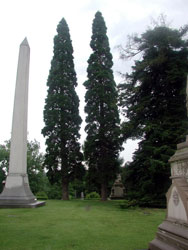Resource Library
Plant of the Week: Incense, California Cedar
The University of Arkansas System Division of Agriculture does not promote, support or recommend plants featured in "Plant of the Week." Please consult your local Extension office for plants suitable for your region.
Plant of the Week
California Incense Cedar
Latin: Calocedrus decurrens

The interplay between language, history and technology represents a fascinating slice of American culture. For example, on my desk set a couple yellow “lead” pencils. These contain a slender piece of lead sandwiched inside a shaft of California incense cedar, an evergreen conifer used almost exclusively in the production of these timeless writing sticks.
California incense cedar (Calocedrus decurrens) is a native west coast tree growing in the Oregon Cascades, the Coastal and Sierra Nevada Ranges of California and adjacent areas of Nevada and into the mountains of the Baja Peninsula of Mexico.
In 1956, three species of Calocedrus (the other two are from China) were separated from the related genus Libocedrus which occurs in the Southern Hemisphere. Acceptance of the new name has been slow so many still list it under the older name.
California incense cedar grows in mixed forest stands with pines and firs where it forms tall, erect columns approaching 100 feet tall. Trunks may grow from 3 feet to 6 feet across. This species belongs to the cypress family and is closely related to arborvitae (Thuja) but differs in the way the scale-like needles are arranged in tight clusters of four on the stems.
In the Mountains of California John Muir says “…the whole tree is thatched with them (the flattened sprays) so that they shed off rain and snow like a roof, making fine mansions for storm-bound birds and mountaineers.”
Lead pencils are an old technology that has survived into the modern age. The pencil owes its existence to the discovery of an enormous and pure deposit of graphite (a form of carbon considered the highest grade of coal) in 16th century England. The locals thought it to be a form of lead and soon discovered its usefulness for writing. Eventually this “lead” was sandwiched inside a piece of wood to protect it from breaking.
In the 1790s, a Frenchman perfected a technique for mixing ground graphite with potter’s clay to create graphite that could be fired to create spaghetti-sized strands. Henry David Thoreau may have been one of the first American pencil makers to employ the graphite-clay process in his father’s pencil shop in Concord.
Pencil manufacturing became automated about the time of the Civil War and remains largely unchanged since that time.
The wooden slabs used to cut pencil blanks were originally made from Eastern red cedar. Most large cedar trees were gone from the Eastern states by the turn of the 20th century, so manufacturers turned to the straight-grained, soft-wooded and easily sharpened incense cedar from western forests. Yellow became the color of choice for pencils after 1890, when an Austrian manufacturer began marketing his pencils – the Koh-I-Noor brand – as the best pencil in the world. American manufacturers soon adopted yellow as their color of choice, thus diluting the appeal of the European competitor.
The California incense cedar is hardy from zones 5 to 8 and is much more widely adapted than generally recognized. It produces slow to moderate growth and will make a 30-foot tall specimen in 20 years and does well across the South. The most common form in cultivation is a columnar clone with old trees having a spread of 10 to 15 feet.
Though this species does best in deep, well-drained, yet reasonably moist soils, California incense cedar is quite drought and heat tolerant. It does well in non-irrigated locations receiving 30 inches of rainfall a year. Plants are adapted to full sun or light shade. It can be used as a stately specimen, for tall screening or in mass plantings as a windbreak or sound barrier.
By: Gerald Klingaman, retired
Extension Horticulturist - Ornamentals
Extension News - January 4, 2008
The University of Arkansas System Division of Agriculture does not maintain lists of retail outlets where these plants can be purchased. Please check your local nursery or other retail outlets to ask about the availability of these plants for your growing area.